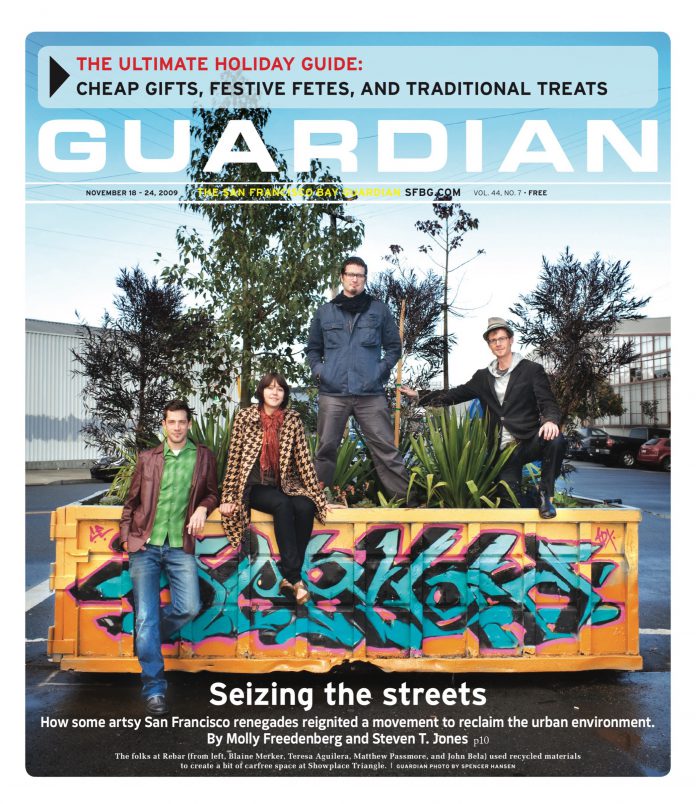arts@sfbg.com
LIT Recently I was at a meeting with an unnamed arts organization, planning for an AfroSurreal art exhibit. As we were hashing out the details of display, the concept of the black dandy become a bone of contention among my learned colleagues. What was, and is, a black dandy? How does the black dandy differ from the white dandy? What’s the difference between a dandy and fop? Aren’t those terms interchangeable? Why bother looking at or for a black dandy at all? I’m seldom at a loss for words — it just takes me a minute to arrange them properly sometimes. (Ask my editor.) But this time, I had nothing to say. I just directed all queries to Slaves To Fashion: Black Dandyism and the Styling of Black Diasporic Identity (Duke University Press, 408 pages, $24.95).
Monica L. Miller’s book is the first of its kind: a lengthy written study of the history of black dandyism and the role that style has played in the politics and aesthetics of African and African American identity. She draws from literature, film, photography, print ads, and music to reveal the black dandy’s underground cultural history and generate possibilities for the future.
Slaves to Fashion looks at black dandies of the past, beginning with Mungo Macaroni, a freed slave and well-known force within the London social scene in the 18th century. Miller also studies contemporary manifestations, in the vestments of Andre 3000 and Puff Daddy, showing how black dandies have historically used the signature tools of clothing, gesture, and wit to break down limiting definitions and introduce new, fluid concepts of social and political possibility. Though Slaves to Fashion is über-academic and at times weighed down by post-structrualist jargon, Miller more than makes up for it with uncanny feats of scholarship that illustrate ways in which the figure of the black dandy has been an elephant-in-the-room — albeit a particualrly well-dressed one.
A great example is Miller’s citing of the character of Adolph in Harriet Beecher Stowe’s 1852 Uncle Tom’s Cabin. Almost immediately after the publication of this "great abolitionist work," its characters became some of the first American archetypes: Simon Legree and Uncle Tom are two notable examples. In comparison, Adolph — a black dandy pivotal to the story — was excised from the public imagination. Miller sees this as a reaction to what she calls "crimes of fashion," which take place when Africans and African Americans don the clothing of the oppressed to both emulate and satirize the oppressor. Adolph served as a "dark mirror" to both American materialism and the deep fear of the impending gender and race-mixing that would take place after abolition.
This fear, according to Miller, is the difference between the black dandy and the white dandy or the fop. Unlike a Caucasian counterpart, exemplified by the likes of Oscar Wilde, the black dandy comes from a position of underprivilege and uses flair and style as a way to redefine masculinity to include him. In other words, as opposed to a feminine front, it is the black dandy’s fluid masculinity — his "queering" of the term — that threatens to undermine the social order. Adolph is the exact opposite of the static, predictable docility and animalism of "the Big Black Buck" Uncle Tom. When he’s in town, you have to lock up your sons, daughters, wives, mother, father, and yourself because his power of seduction is so great. Think Prince during his Dirty Mind (Warner Bros., 1980) phase and you get the general idea.
Fear, according to Miller, continues to generate a serious backlash in reaction to the idea — let alone reality — of true equality for black people in the west. Images of black cork minstelry that lampoon the black dandy’s aspirations have been around as long as the black dandy. From Zip Coon and Jim Dandy in the early 19th century to present-day manifestations in popular culture, ambivalence — a tool of the black dandy — has served as a double-edged sword. Exactly when and where does "stylin’ out" become "coonin’"? If W.E.B. Du Bois, the quintessential black dandy, couldn’t figure it out, I’m not sure that I can find a definitive answer.
Slaves to Fashion rediscovers its footing in exploring the nature of "otherness." Returning from investigations of the black dandy’s lineage to note his role in contemporary art and culture, Miller shines a light on filmmaker Isaac Julien, editor and photographer Iké Udé, visual artist Yinka Shonibare, and beyond. In the process, she answers a variety of questions regarding what a black dandy is and does. Ultimately, the black dandy’s problem is an AfroSurreal one: by perpetrating these "crimes of fashion," by avoiding and exploding pat definitions of blackness, masculinity, and sexuality, he occupies a realm outside convention, and all too often, recognition. It is from these murky waters of post-postmodernity, I believe, that the black dandy brings a message for us all.

